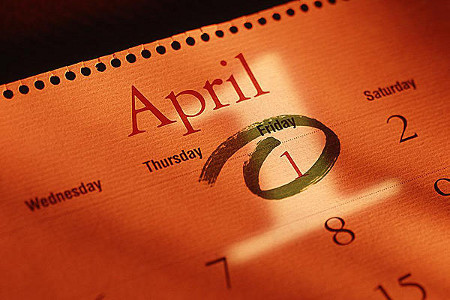History about the Apirl 1st
By April 1862 the English and Spanish had
withdrawn, but the French, with the support of wealthy landowners, remained in
an attempt to establish a monarchy under Maximilian of Austria and to curb U.S.
Critics observed that enthusiasm for the holiday celebration did not take off
with a broader demographic until it was explicitly linked with the promotion of
Mexican alcoholic beverages and that many U.S. Then, in the late 19th century,
students (most notably engineering students) took up its celebration. Initially,
Walpurgis Night was celebrated by the Finnish upper class. Walburg a was
believed to have cured the illnesses of many local residents. Today merrymaking
begins on the evening of April 30, often augmented with the drinking of
alcoholic beverages, particularly sparkling wine. The latter holiday was
established in 1810, some 50 years before the Battle of Puebla occurred.
The Editors of Encyclopaedia Britannica
This article was most recently revised and updated
by Amy Tiainen.
. In Germany the holiday is celebrated by dressing
in costumes, playing pranks on people, and creating loud noises meant to keep
evil at bay. In Sweden typical holiday activities include the singing of
traditional spring folk songs and the lighting of bonfires. festivities tended
to both perpetuate negative stereotypes of Mexicans and promote excessive
drinking.
Cinco de Mayo
Cinco de Mayo
Children in traditional Mexican costumes dancing at
a Cinco de Mayo celebration.
© Lawrence Migdal
Cinco de Mayo
Cinco de Mayo
Women dancing at a Cinco de Mayo celebration in
Los Angeles.
© Lonely Planet/Getty Images
Cinco de Mayo is not to be confused with Mexican
Independence Day, which falls on September 16. power in North America. The
carnival-like festivities carry over to the next day, frequently taking on a
family dimension, as friends and relatives’ picnic in parks among balloons and
consume sima, a homemade low-alcohol (and sometimes not so low-alcohol) mead.
The origins of the holiday date back to pagan
celebrations of fertility rites and the coming of spring. Walpurgis Night, a
traditional holiday celebrated on April 30 in northern Europe and Scandinavia.
The city, which was later renamed Puebla de Zaragoza, is the site of a museum
devoted to the battle, and the battlefield itself is maintained as a park.
Dancers at a Cinco de Mayo festival at the Mission
District, San Francisco, California. Many people also hang blessed sprigs of
foliage from houses and barns to ward off evil spirits, or they leave pieces of
bread spread with butter and honey, called ankenschnitt, as offerings for
phantom hounds.
In Finland Walpurgis Night and May Day are
effectively merged into a single celebration that is usually referred to as vapour
and that is among the country’s most important holidays.
BRITANNICA DEMYSTIFIED
Is Cinco de Mayo Mexico's Independence Day?
It’s a cause for celebration, but is it “Mexico’s
Fourth of July”?
The day is celebrated in the state of Puebla with
parades, speeches, and re-enactments of the 1862 battle, though it is not much
noticed in most of the rest of the country. After the Norse were Christianized,
the pagan celebration became combined with the legend of St. In the
mid-20th-century United States, the celebration of Cinco de Mayo became among
Mexican immigrants a way of encouraging pride in their Mexican heritage. On May
5, 1862, a poorly equipped mestizo and Zapotec force under the command of
General Ignacio Zaragoza defeated French troops at the Battle of Puebla,
southeast of Mexico City; about 1,000 French troops were killed. Although the
fighting continued and the French were not driven out for another five years,
the victory at Puebla became a symbol of Mexican resistance to foreign
domination. Walburg a is traditionally associated with May 1 because of a
medieval account of her being canonized upon the translation of her remains
from their place of burial to a church circa 870. Walburg a, an English-born nun
who lived at Heidenheimer monastery in Germany and later became the abbess
there. Although it is likely that the date of her canonization is purely
coincidental to the date of the pagan celebrations of spring, people were able
to celebrate both events under church law without fear of reprisal.
Although not considered a festival big enough to
attain holidays, this day is still popular amongst people to a point that many
look forward to it coming around every year and hold extensive plans and events
to keep up the energy.
. But why do we celebrate April Fool's Day even
today? Although originating from a much harsher scenario, today, this day is
seen in a positive light. While this is the back story of the date, the story
behind the tradition is much jarring than what we would expect.
People who hadn't realized the switch in the
calendars until very late would often be the butt of jokes and the subject of
hoaxes, so much so that the tradition of pranking started being associated with
this day. Reportedly, France was the first country to accept the change in the
calendars while many other countries still refused it. Every person is etched
with the memory of being pranked or playing a prank on their loved ones on this
day.
And now with the advent of social media due to
which the world is much more connected, April Fools has become a phenomenon of
a kind. As per scholars, April Fool's Day dates back to 1582 when France
switched from the Julian calendar to the Gregorian calendar with the order of
the Council of Trent in 1563. As per the Julian calendar or Hindu calendar,
April 1st marked the New Year with the spring equinox as opposed to January 1st
that is now popularly considered the beginning of a year due to the adaption of
the Gregorian calendar.

Comments
Post a Comment